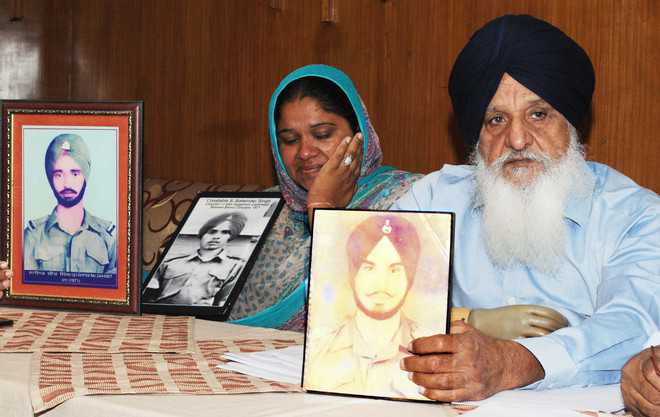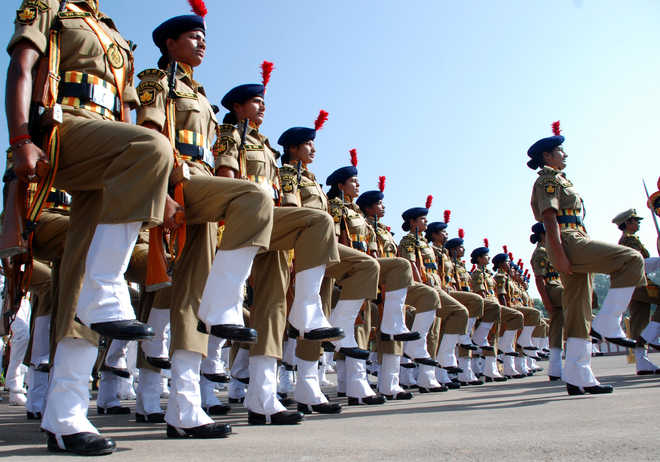
Capt CS Sidhu (retd) and Baljinder Kaur (left) seek the release of prisoners of war languishing in Pakistani jails, in Amritsar on Thursday. photo: vishal kumar
GS Paul
Tribune News Service
Amritsar, May 26
Expressing solidarity with the prisoners of war (PoWs) languishing in Pakistan jails, the United Ex-servicemen Front today announced to stage a protest rally at the Attari-Wagah border in July if the Centre failed to initiate steps to get them released.Having traced three such cases of the 1971 war, the front’s in-charge, Capt CS Sidhu (retd), said they would not refrain from disrupting the operations of the Samjhauta Express and the Indo-Pak Dosti bus if the government did not act.The front said the three PoWs had been identified as Sepoy Balwinder Singh of the 10th Sikh Regiment, Sepoy Dharam Pal Singh Dhurkot of the 4th Sikh Regiment and Sepoy Bir Singh of the 15th Punjab Regiment.Baljinder Kaur, daughter of Sepoy Balwinder Singh, hailing from Chabba Kalan Havelian village in Tarn Taran, said she was born after her father’s disappearance. She said Surjit Singh, who had been released from the Kot Lakhpat jail in 2012, had claimed that her father was alive.“I have seen my father only in pictures. He has been missing since December 16, 1971. I urge the governments of India and Pakistan to reunite us with him,” she said.Arshinder Pal Singh, son of Dharam Pal Singh of Lehra Dhurkot (Bathinda), said, “Satish Kumar of Ferozepur, who was released in 1986 from a Pakistan jail, told us that my father was lodged in the Kot Lakhpat jail since 1971. When he told us about a folk song my father used to sing, we were sure about him,” he said.Captain Sidhu said he had written a letter to the Defence Minister to intervene and take up the matter with his Pakistani counterpart to facilitate the PoWs’ release.“Both India and Pakistan have war prisoners, but no side is ready to admit it. We want that Pakistani prisoners lodged in Indian jails be released and vice-versa,” he said.
Families of 1971 prisoners of war seek their release
AMRITSAR: “I don’t want a government job or any other benefits, my only wish is to see my father back home,” said Baljinder Kaur, whose father sepoy Balwinder Singh of the 10 Sikh Regiment had gone missing in the 1971 Indo-Pak war.
SAMEER SEHGAL /HTUnited Ex-servicemen Front chief Capt CS Sidhu (retd) with Baljinder Kaur, whose father is languishing in the Lahore jail, at a press conference in Amritsar on Thursday.
Speaking at a press conference organised by the United Ex-servicemen Front for the release of the prisoners of war (PoW) languishing in Pakistan jails, here on Thursday, Baljinder said: My father was declared dead on December 16, 1971, but we come to know recently that he is alive. A war prisoner, Surjeet Singh, who was released by the Pakistan authorities in 2012, had made this announcement at Chaba village near Amritsar. But we didn’t get this information at that time as we live in far-off Chamba Kalan village in Tarn Taran district.”
“My father was declared dead on December 16, 1971, but we come to know recently that he is alive. A war prisoner, Surjeet Singh, who was released by the Pakistan authorities in 2012, had made this announcement at his village. But we didn’t get this information at that time as we live in far-off Chamba Kalan village in Tarn Taran district.”
Chairman of the front captain CS Sidhu (retd) said: “The Indian government should step up efforts to ensure release of prisoners of war. If the government fails to do so, we will block the Attari-Wagah border in July and stop trade bus and train services between India and Pakistan.”
“There are many war prisoners from Pakistan in our jails too and their families are also suffering,” he added.
The front has written to defence minister Manohar Parrikar seeking release of Balwinder, who according to Surjeet is lodged in Lahore’s Kot Lakhpat jail.
Arshinder Singh, son of another prisoner of war havildar Dharampal Singh, said “We recently came to know that he is alive. We want him back.”
Baljinder claimed that nayak Bir Singh of the 15 Sikh Regiment from a village in Mansa was also languishing in the Lahore jail.



































































